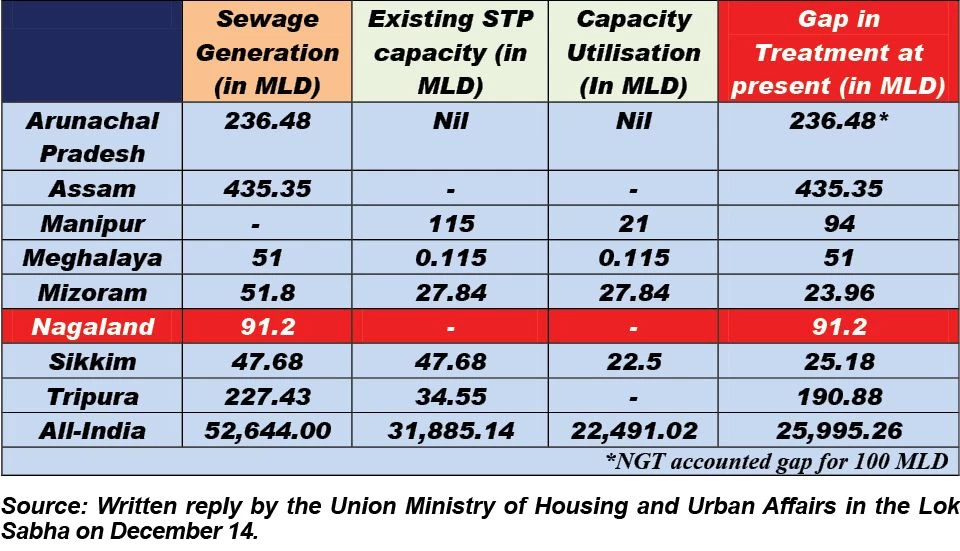Morung Express News
Dimapur | December 15
During the period from July 7, 2022, to May 11, 2023, the total sewage generation in Nagaland was estimated to be 91.2 million litres per day (MLD), and none is treated, informed data provided by the Union Ministry of Housing and Urban Affairs (MoHUA) in the Lok Sabha on December 14.
Incidentally, it further showed there is no existing Sewage Treatment Plants (STPs) in the State, and accordingly, the gap in the treatment of sewage stood at 91.2 MLD.

The data is based on the information provided by all the 36 States/Union Territories (UTs) to the National Green Tribunal (NGT) and reflected in its order dated May 22, 2023, Minister of State MoHUA, Kaushal Kishore said in a written reply.
Among the North-East States, Mizoram seems to be managing the sewage better with 27.84 MLD of 51.8 MLD being treated and the lowest gap in treatment at 23.96. Sikkim was next with 22.5 out of 47.68 MLD of sewage being treated and a gap of 25.18.
Apart from Nagaland, Arunachal Pradesh and Assam, NE’s two highest sewage generating states at 236.48 and 435.35 respectively, had no existing STP.
The total sewage generation in the country was 52,644.003 MLD, while the total STP capacity is shown to be 25,995.26 MLD. The total gap in treatment was 25,995.26 MLD.
The status indicated in the data regarding Nagaland is intriguing. It must be noted here that Nagaland unveiled its first Sewage Treatment Plant (STP) with a capacity of 25.43 MLD in Shozukhu village on January 14, 2023. However, the NGT order, according to the written reply, did not reflect this development.
Accordingly, if this is taken into account, the gap comes down to 65.77 MLD.
A recent affidavit filed on behalf of the Nagaland Government informed that a gap of 65.67 MLD remains in sewage treatment.
Meanwhile, MoS Kishore attributed rapid urbanisation, an increase in the number of towns/cities, and rapid growth of the population to an increase in sewage generation in India. He further said that public health and sanitation are State subjects, and it is the responsibility of State/Urban Local Bodies to plan, design, execute and operate sanitation projects in the urban areas of the country. However, the Government of India supplements the efforts of the States/ULBs in providing infrastructure for basic services such as sewerage infrastructure including STPs in urban areas through its various flagship missions, he said.
The STPs are constructed under four central schemes- Atal Mission for Rejuvenation and Urban Transformation (AMRUT); Swachh Bharat Mission (Urban); Namami Gange Programme implemented by the Ministry of Water Resources, River Development and Ganga Rejuvenation; and National River Conservation Plan implemented by the Ministry of Environment, Forest and Climate Change.
As per the data provided by the States/ UTs to SBM – Swacchatam portal, currently, the total municipal waste generated in urban areas is approx. 1.5 Lakh tonnes per day, out of which approximately 76% of the total waste generated is being processed, the MoS added.







 What Does Your Face Say About Your Health?
What Does Your Face Say About Your Health? The Top Viral YouTube Videos of 2017
The Top Viral YouTube Videos of 2017 The last Konyak headhunters of Nagaland
The last Konyak headhunters of Nagaland An orbiting message of peace
An orbiting message of peace










Leave a Reply
Your email address will not be published. Required fields are marked (required)